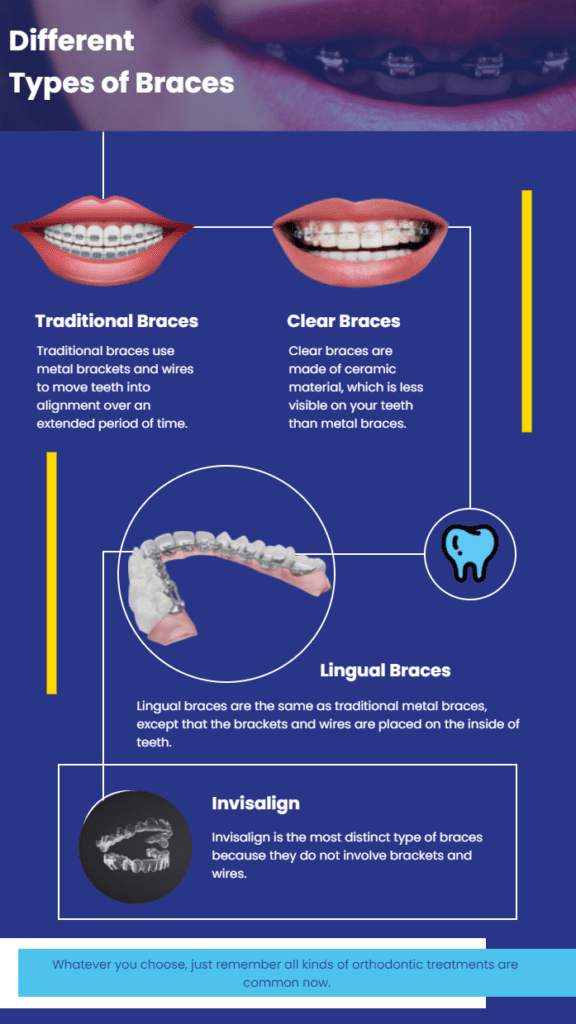The Benefits of Choosing a Cumming Orthodontist for Your Braces and Aligners
The Benefits of Choosing a Cumming Orthodontist for Your Braces and Aligners
Blog Article
Comprehensive Overview to Orthodontics Treatments for Dealing With Dental Misalignments
In the realm of orthodontics, the journey to achieving a perfectly lined up smile involves a myriad of treatments tailored to remedy oral misalignments. From conventional braces to unnoticeable aligners and even surgical alternatives, the field of orthodontics uses a series of options to deal with varying degrees of dental irregularities. Recognizing the details of each treatment, including their mechanisms, advantages, and possible drawbacks, is vital in making notified choices concerning one's orthodontic treatment. As we browse through the detailed guide to orthodontic treatments for correcting oral imbalances, the complex details of each technique will unfold, dropping light on the path toward a harmonious and functional oral alignment.
Orthodontic Procedures Overview

Routine adjustments and tracking are critical parts of orthodontic therapy to guarantee progression is on track and to make any necessary modifications along the method. By undertaking orthodontic treatments, people can not only achieve a straighter smile yet likewise boost their general oral health and wellness and feature.
Conventional Braces: How They Work
When taking into consideration orthodontic therapies for dental imbalances, traditional braces attract attention as a tried and true technique for dealing with teeth positioning. Conventional braces include braces, cords, and bands that work together to use continual pressure on the teeth, progressively relocating them into the wanted placement. The brackets are connected to the teeth utilizing a special adhesive, and the wires are threaded through the braces. By readjusting the tension of the cables, orthodontists can regulate the instructions and force related to each tooth, leading them into proper positioning with time.
As stress is used to the teeth through the braces, the bone surrounding the teeth is reshaped to sustain the brand-new tooth positions. People will certainly require normal changes at the orthodontist's workplace to ensure the braces proceed to use the appropriate stress for reliable teeth motion.
Unseen Aligners: Advantages And Disadvantages
Invisible aligners use a convenient and discreet alternative to conventional braces for fixing oral misalignments. These clear, custom-made trays are basically invisible when used, making them an attractive option for individuals looking for a much more visually pleasing orthodontic treatment. Among the primary advantages of unnoticeable aligners is their removability, enabling much easier maintenance of oral health contrasted to traditional dental braces. People can eliminate the aligners prior to consuming or brushing their teeth, minimizing the risk of food getting stuck in the home appliance and streamlining the cleaning procedure.

Surgical Orthodontic Options
Surgical interventions in orthodontics present sensible choices for dealing with complex dental imbalances that might not be properly fixed with standard orthodontic treatments. While undetectable aligners and standard dental braces can fix many orthodontic problems, particular cases need surgical intervention to attain optimal results. Surgical orthodontic alternatives are generally suggested for severe malocclusions, significant jaw disparities, and cases where the underlying bone structure needs modification to attain proper alignment.
One typical surgical orthodontic treatment is orthognathic surgical treatment, which includes repositioning the jaws to best endodontist near me remedy functional concerns such as difficulty eating or speaking. This surgical treatment is frequently done in cooperation with an orthodontist who aids align the teeth prior to and after the treatment. Surgical orthodontics may additionally include treatments to expose influenced teeth, remove excess periodontal tissue, or reshape the jawbone to create a more harmonious face profile.
Before taking into consideration surgical orthodontic alternatives, patients go through a detailed evaluation to figure out the requirement and possible advantages of such interventions. cumming orthodontist. While surgery might seem complicated, it can dramatically improve both the function and appearances of the smile in situations where traditional orthodontic treatments fail
Retainers and Post-Treatment Treatment

Post-treatment treatment involves adhering to the orthodontist's directions faithfully. This might consist of correct oral hygiene practices, going to follow-up visits, and wearing the retainers as recommended. Failing to follow post-treatment treatment guidelines can lead to regression, where the teeth gradually move back in the teeth whitening treatment direction of their initial settings. Regular retainer wear, excellent oral health, and routine dental examinations are essential for keeping the results achieved with orthodontic surgical treatment and ensuring the long-term stability of the fixed dental placement.
Verdict
In conclusion, orthodontic procedures provide various options for correcting dental imbalances. Conventional braces make use of metal brackets and cords to shift teeth into appropriate positioning. Undetectable aligners provide a more very discreet alternative however might not be ideal for all cases. Surgical orthodontic choices are readily available for much more severe imbalances. Retainers are frequently used post-treatment to maintain the new placement. Overall, orthodontic treatments can effectively enhance dental health and wellness and visual look.
As we browse via the comprehensive overview to orthodontic procedures for dealing with oral imbalances, the complex information of each approach will unravel, shedding light on the path toward a useful and harmonious oral positioning. - cumming orthodontist
One of the most usual orthodontic therapies is the usage of dental braces, which consist of steel brackets and cables that apply gentle pressure to progressively shift teeth right into the desired position.When taking into consideration orthodontic treatments for dental imbalances, traditional braces stand out as a time-tested approach for dealing with teeth placing. Furthermore, undetectable aligners may not be suitable for intricate orthodontic problems that require more substantial teeth activity, as they are generally suggested for mild to moderate instances. Retainers are tailor-made orthodontic tools designed to hold teeth in their corrected positions after the completion of orthodontic therapy.
Report this page